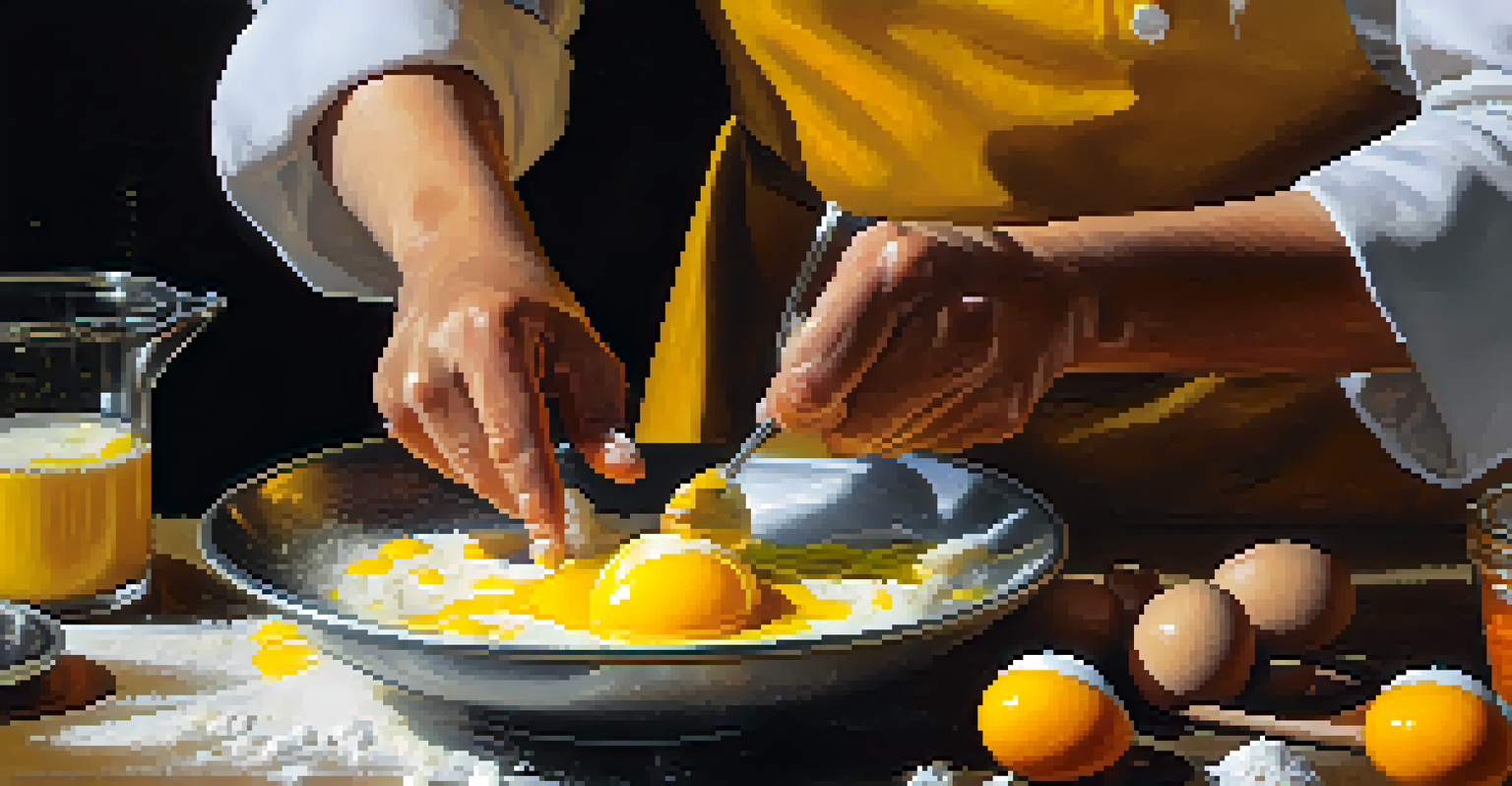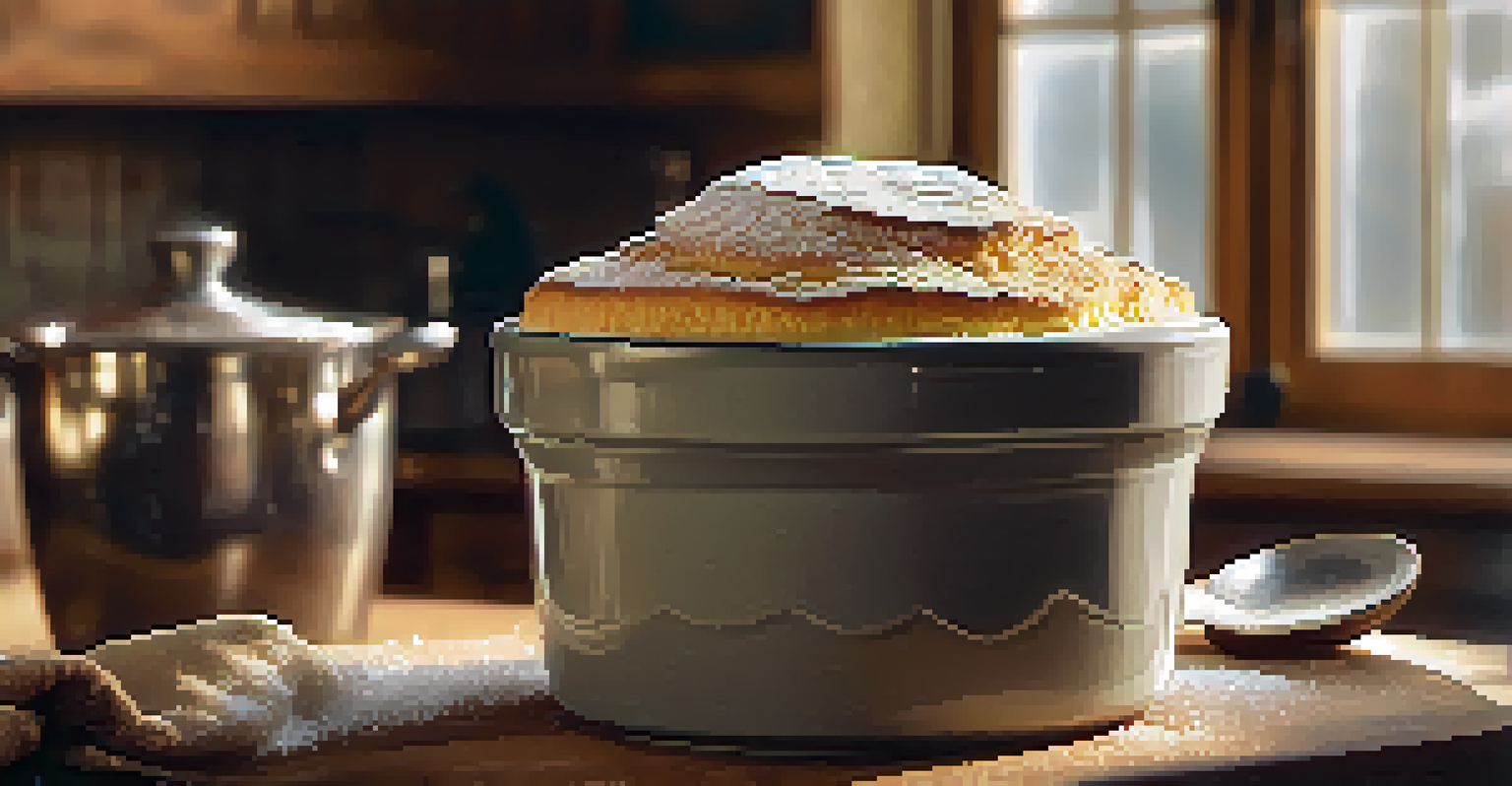The Role of Eggs in Pastry Making: Binding and Leavening

Understanding the Basics: What Eggs Do in Pastry
Eggs are a versatile ingredient in pastry making, serving multiple key functions. They contribute to both binding and leavening, playing a crucial role in the texture and structure of baked goods. When combined with other ingredients, eggs can create a cohesive mixture that holds everything together, ensuring your pastry doesn’t crumble apart.
Eggs are the glue that holds everything together in baking.
The proteins in eggs coagulate when heated, which helps to solidify the pastry and gives it structure. This is particularly important in recipes like custards and tarts, where a stable form is essential. Without the binding power of eggs, you might end up with a soggy or crumbly mess instead of a delicious dessert.
In addition to binding, eggs also add moisture and richness to pastries, enhancing their overall flavor. Think of eggs as the glue and the secret ingredient that helps elevate your pastries from good to unforgettable.
Binding Agents: How Eggs Hold Pastry Together
Binding is one of the primary roles of eggs in pastry making. The proteins in eggs, particularly egg whites, work to cling to other ingredients, creating a unified mixture. This property is essential in recipes like pie crusts and cookie dough, where a cohesive texture is necessary for proper baking.

When you mix eggs into your pastry dough, they help to create a web-like structure. This structure traps air and moisture, contributing to the final product's tenderness and chewiness. Without this binding effect, pastries would lack the desired texture and could easily fall apart.
Eggs Bind and Structure Pastries
Eggs play a crucial role in binding ingredients and providing structure, ensuring pastries hold together and maintain their shape.
Think of eggs as the foundation of a building; just as a strong foundation keeps a structure standing tall, eggs ensure your pastries hold together beautifully and maintain their shape during baking.
Leavening Power: How Eggs Help Pastry Rise
In addition to binding, eggs provide essential leavening properties in pastry making. When eggs are beaten, they incorporate air, which expands during baking, causing the pastry to rise. This is particularly important in sponge cakes and soufflés, where a light, fluffy texture is desired.
Baking is like chemistry, but with delicious results.
The two types of leavening in eggs—mechanical and chemical—work together. Mechanical leavening occurs when air is whipped into the egg whites, while chemical leavening happens when the proteins in the eggs interact with other ingredients during baking. The result is a delightful lift that gives pastries their airy quality.
Imagine blowing up a balloon; the more air you put in, the bigger it gets. Similarly, the air trapped in eggs expands when heated, providing that delightful rise in your baked goods.
Types of Eggs: Choosing the Right One for Your Pastry
Not all eggs are created equal, and the type you choose can impact your pastry's final outcome. Standard chicken eggs are most commonly used, but there are also options like duck or quail eggs that can offer unique flavors and textures. Each type of egg has a different size and yolk-to-white ratio, which can affect binding and leavening.
For instance, duck eggs are larger and have a higher fat content than chicken eggs, making them great for rich pastries. On the other hand, quail eggs, while smaller, can add a delicate touch to gourmet creations. Understanding the differences can help you select the best egg for your specific pastry needs.
Eggs Provide Essential Leavening
When beaten, eggs incorporate air that expands during baking, contributing to the rise and light texture of pastries like sponge cakes and soufflés.
Choosing the right egg is like picking the perfect paint for a masterpiece; it can dramatically alter the final result, so it’s worth considering your options.
Egg Substitutes: What to Use When You Can't Use Eggs
Sometimes, you might find yourself needing to replace eggs in a recipe, whether due to dietary restrictions or personal preferences. Luckily, there are several effective egg substitutes that can still provide binding and leavening properties. Common alternatives include applesauce, mashed bananas, or even flaxseed meal mixed with water.
For example, using applesauce can add moisture and sweetness while helping to bind ingredients together. Flaxseed meal, when mixed with water, forms a gel-like substance that mimics the binding qualities of eggs. These alternatives can work wonders, but it’s essential to experiment to achieve the desired texture.
Consider substitutes as a creative twist on traditional recipes; they can lead to delicious new discoveries and make your pastries accessible to everyone.
The Science Behind Eggs in Pastry: A Closer Look
The science of how eggs function in pastry making is fascinating. When heated, the proteins in eggs denature, meaning they unravel and re-bond with other proteins, creating a network that stabilizes the pastry structure. This process is crucial for achieving the right texture and consistency in baked goods.
Additionally, the emulsifying properties of egg yolks help to blend fat and water in doughs, preventing separation and ensuring a smooth mixture. This is particularly important in recipes that call for rich, buttery pastries where a harmonious blend of ingredients is key.
Choose the Right Eggs for Pastries
Different types of eggs, such as chicken, duck, or quail, can affect the flavor and texture of pastries, making it important to select the right one for your recipe.
Understanding the science behind eggs in your pastry is like having a secret recipe book; it gives you insight into why certain techniques work, helping you become a more confident baker.
Tips for Using Eggs in Pastry Making
To get the most out of eggs in your pastry making, start by using eggs at room temperature. This helps them incorporate more easily into your mixture, leading to better binding and leavening. Additionally, consider separating your eggs; whipping the whites separately can create more volume and lightness in your baked goods.
Another tip is to avoid overmixing once you add the eggs to your dough. Overmixing can lead to tough pastries, so mix just until everything is combined. This will help you achieve that tender, flaky texture we all love.

Think of making pastry as a dance; each step must be timed perfectly to achieve the best results. By following these tips, you can ensure your egg-based pastries come out deliciously every time.